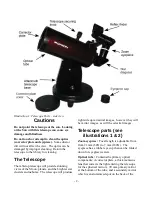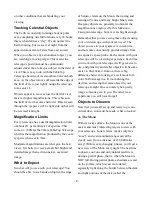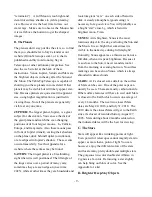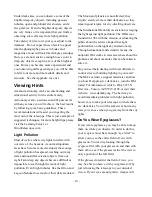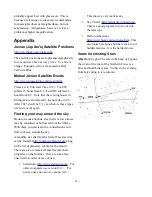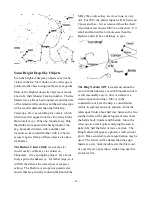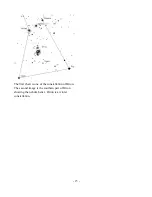
“terminator”). A full Moon is too bright and
devoid of surface shadows to yield a pleasing
view. However it is the best time to trace out
crater rays. Make sure to observe the Moon when
it is well above the horizon to get the sharpest
images.
B. The Planets
The planets don’t stay put like the stars, so to find
them you should refer to Sky Calendar at our
website (OrionTelescopes.com), or to charts
published monthly in Astronomy, Sky &
Telescope, or other astronomy magazines. See
also the web site list at the back of these
instructions. Venus, Jupiter, Saturn and Mars are
the brightest objects in the sky after the Sun and
the Moon. The TableTop Telescope is capable of
showing you these planets in some detail. Other
planets may be visible but will likely appear star-
like. Because planets are quite small in apparent
size, using higher magnification is justified in
viewing these. Not all the planets are generally
visible at any one time.
JUPITER:
The largest planet, Jupiter, is a great
subject for observation. You can see the disk of
the giant planet and watch the ever-changing
positions of its four largest moons – Io, Callisto,
Europa, and Ganymede. Also these moons pass
in front of Jupiter (transit), casting their shadows
on the planet, duck behind Jupiter (occultation),
or are eclipsed in Jupiter's shadow. These events
occur almost daily. See the Appendix for a
website where these times may be found.
SATURN:
The ringed planet is a breathtaking
sight when it is well positioned. The tilt angle of
the rings varies over a period of many years;
sometimes they are seen edge-on (next time
2025), while at other times they are broadside and
look like giant “ears” on each side of Saturn’s
disk. A steady atmosphere (good seeing) is
necessary for a good view. You will probably see
a bright “star” close by, which is Saturn’s
brightest moon, Titan.
VENUS:
At its brightest, Venus is the most
luminous object in the sky, excluding the Sun and
the Moon. It is so bright that sometimes it is
visible to the naked eye during full daylight!
Ironically, Venus appears as a thin crescent, not a
full disk, when at its peak brightness. Because it
is so close to the Sun, it never wanders too far
from the morning or evening horizon. No surface
markings can be seen on Venus, which is always
shrouded in dense clouds.
MARS:
At it's closest some detail on the surface
of Mars can be seen. One of the polar caps can
usually be seen. These are mostly carbon dioxide.
Other surface features will have to wait until Mars
is closest to the Earth which occurs on average of
every 26 months. The next two closest Mars
dates are May 20, 2016, and July 31, 2018. The
2018 date is the closest Mars will get to the Earth
since it's closest of recorded history August 27,
2003. Mars during about 4 months centered on
the indicated dates will be the best for viewing.
C. The Stars
Stars will appear like twinkling points of light.
Even powerful telescopes cannot magnify stars to
appear as more than a point of light. You can,
however, enjoy the different colors of the stars
and locate many pretty double and multiple stars.
The gorgeous two-color double star Albireo in
Cygnus is a favorite. Defocusing a star slightly
can help bring out hints of color. See the
Appendix for a list.
D. Brighter Deep-Sky Objects
- 9 -
Summary of Contents for StarMax 90
Page 16: ......


